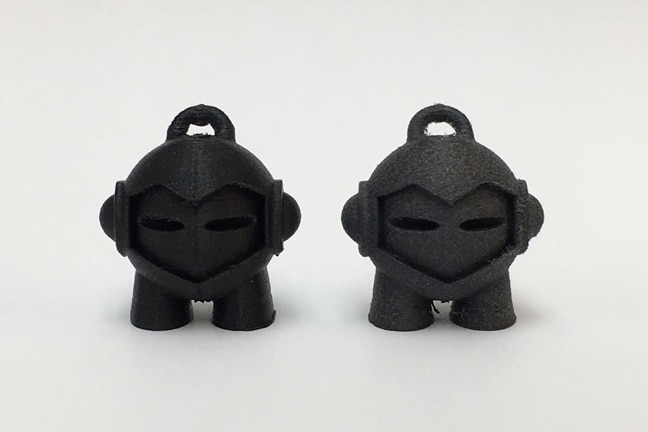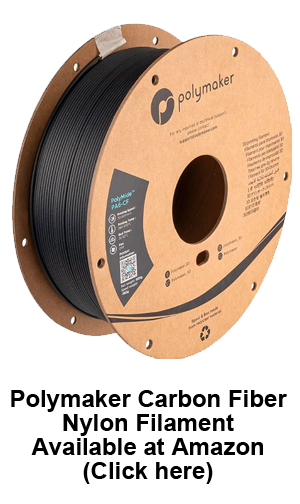
Should you be 3D Printing with nylon?
In the world of home/hobby 3D printing, PLA material is by far the most popular filament material to use. It’s easy to print, cheap, melts at a lower temp, and doesn’t emit a harsh smell. Plus its made from cornstarch or sugar cane, so its biodegradable and just generally seems like a more harmless material to be working with.
There are some down-sides to PLA:
- It’s brittle and can break easily
- Does not hold up well under heat
- Degrades in the sun and outdoor elements
- Not considered a professional grade material
Though professional consideration does not affect the home user, it’s worth looking at what materials are considered more industrial, and can you work with them at home?
Is it difficult to 3D print with nylon?
The short answer is “yes”. Nylon first of all is hygroscopic, meaning it will absorb moisture from the air. This moisture, when in contact with the hotend of your 3D printer, can boil and create a number of extrusion problems, from under-extrusion, to “drooling” and stringing material all over your part. The best way to combat this is to keep your filament dry by first drying it, and then storing it in a drybox. If you want a reference on how nylon is 3D printed reliably, check out a Markforged brand composite 3D printer. They store their filament in an airtight Pelican case connected to the printer using bowden tubes. The result is dry material and reliable, high-quality printing with nylon based filament. This can be emulated even on a simple home user’s machine.
Beyond the moisture issue, nylon also likes to curl when cooling and contracting, especially if you print with dense infill. I’ve found that materials like carbon fiber filled nylon are much more dimensionally stable than standard nylons. The carbon fiber helps to keep the parts flat and adds a good amount of stiffness to the otherwise flexible nylon parts.
My biggest recommendation if you need to build a robust part, is to print with carbon fiber filled nylon. Print reliability goes way up with this material compared to standard nylon. Just be sure you are using a hardened nozzle, as carbon fiber is abrasive and will ruin standard brass quickly.
Temperature – another potential issue depending on your printer is the temperature required to properly print nylon. Some materials print best at temps as high as 270C. If you don’t have an all metal hotend, you may need to upgrade your hardware before attempting to print nylon.
Bed – In my research, I’ve found that nylon sticks best to hot glass and cold garalite. Referring back to the Markforged printers (which print only in nylon based materials), their print bed is made of garalite, and they recommend adding glue stick for adhesion and assisting in release of the part. In my testing on my Prusa Mk2, adding glue stick to the PEI covered bed seems to work well, with a temp of 90-100C.
Benefits of Nylon
It’s Tough
I hesitate to use the word “indestructible”, but nylon printed parts are pretty close. Compared to a similar design printed in PLA or ABS, a part produced in nylon is going to be much tougher. Carbon fiber filled nylons can be in the neighborhood of 30% stronger and stiffer than ABS. Layer adhesion is also great because it is printed at a higher temp. I don’t see any issues with delamination with nylon parts, and Z-axis strength is much higher (can’t break off benchy’s smoke stack!).
It can be any color you want
If you’re using a standard translucent nylon, you can actually dye your 3D printed part using fabric dye. The process is actually pretty quick and easy, and a more permanent and flexible solution solution compared to either painting, or stocking different colors of filament.
I don’t think a tie-dye effect is possible, but with the right fixturing, you could probably dye different sections of a print each a different color.
It’s Chemical Resistant
If you have an application that requires your 3D printed part to face some harsher environments, or questionable chemicals, nylon can stand up to many solvents, short of acids.
It’s freakin’ Nylon!
When explaining to the world that something is 3D printed, at best you’ll be able to convey that its made of plastic, and maybe (if you’re printing ABS) you can let them know it’s the same material used to make Legos. Most people know what nylon is, and would recognize it as a superior material. This gives some added clout to any parts you make. Not to mention that your parts will likely function better and hold up longer. Almost all PLA fidget spinners break when dropped (eventually). It’s also the same type of material used in production level 3D printers that use Selective Laser Sintering (SLS) technology with nylon powder beds. The “big boys” are printing with nylon. Form Labs is coming out with the Fuse-1 which is also a small form-factor nylon based SLS printer. It’s seeming like when the industry wants to 3D print “real” parts, they’re made in nylon.
When should I NOT use nylon?
If you are printing with Carbon Fiber Filled nylon, then in my opinion, it’s a great general use material that prints easily, supports break away easily, and surface finish is typically great. Cost is probably the biggest reason why you couldn’t use CF Nylon for all projects. It tends to cost as much as 10x the cost of a roll of cheap PLA. Though competition is growing for this material, and prices are getting closer to 3X the cost with some brands.
With standard nylon, I would suggest not printing anything requiring a lot of supports. Because the nylon prints at such a high temp and bonds so well, supports do not tear away easily and require a lot of additional cleanup. Bridging is nearly impossible due to the high print temp, so there are some designs that simply aren’t a good fit for printing printed in nylon, unless you’re willing to spend the time trimming off supports and sanding. You can wet sand nylon to a very smooth finish.
Nylon is not the best choice for for water applications
Since nylon absorbs water, its possible for the material to swell and degrade after long term exposure. It eventually will stabilize with a fixed amount of water absorbed (~3%) but I have heard claims of parts degrading and and falling apart after long term under-water use, especially in salt water. I haven’t seen these results first hand, but the warning is out there.
It’s not the most economical material choice
Obviously we all know that you can get a decent 1kg spool of PLA material for about $20. Nylon and certainly carbon fiber nylon is more expensive, but there are affordable options. You can get a 1kg roll of nylon for around $30, and the cheapest CF nylon for about $65. There are certainly more expensive brands of nylon, but the cost doesn’t have to be 2x or more than that of PLA.
Since printing with nylon is more difficult, it may be worth developing and testing a part with PLA, and once the design is finalized, move on to printing in nylon.
Amazon had some inexpensive options, and I do think the the level of difficulty in printing nylon is pretty high, so consider that when you see poor review ratings for nylon material.
Conclusion
Nylon is not for everyone, and if you’re only downloading files from Thingiverse, I would probably say “don’t bother”. But if you’re designing real use parts, printing with nylon or CF nylon can take your designs to the next level.
NYLON Filament - Available at Amazon.com
As an Amazon Associate I earn from qualifying purchases


